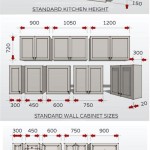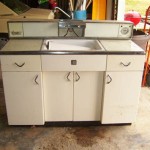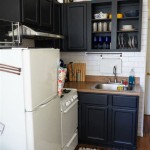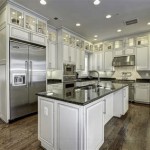Can I Paint Cherry Kitchen Cabinets? A Comprehensive Guide
Cherry kitchen cabinets possess a timeless elegance and inherent warmth that appeals to many homeowners. However, trends evolve, and the existing cherry finish might no longer align with a desired aesthetic. Painting cherry cabinets is a viable option for updating a kitchen's appearance, but it is a process that requires careful consideration and meticulous execution to achieve a professional and lasting result. This article details the complexities involved in painting cherry cabinets, outlining the necessary steps, potential challenges, and considerations for a successful transformation.
The decision to paint cherry cabinets should not be taken lightly. It involves a significant investment of time, effort, and resources. Before embarking on this project, it is imperative to evaluate the current condition of the cabinets, the desired outcome, and personal skill level. Furthermore, weighing the pros and cons of painting versus other alternatives, such as refacing or replacing the cabinets, is essential to make an informed decision.
Cherry wood, characterized by its fine grain and reddish hue, presents unique challenges when it comes to painting. The wood's inherent tannins can bleed through paint, discoloring the finish over time. The smooth surface of cherry also requires thorough preparation to ensure proper paint adhesion. Overcoming these challenges requires a systematic approach and the utilization of appropriate materials.
Key Point 1: Preparation is Paramount
The success of any painting project, particularly one involving cherry cabinets, hinges on meticulous preparation. Inadequate preparation can lead to poor adhesion, uneven coverage, and premature paint failure. The following steps are crucial for preparing cherry cabinets for painting:
1. Removal and Labeling: Begin by carefully removing all cabinet doors, drawers, and hardware (knobs, pulls, hinges). Label each piece with a corresponding number or letter system to ensure proper reinstallation. This step is crucial for maintaining the original configuration and preventing confusion during reassembly.
2. Cleaning: Thoroughly clean all cabinet surfaces with a degreaser to remove grease, grime, and dust. Kitchen cabinets are particularly susceptible to grease build-up, which can hinder paint adhesion. Rinse the cabinets with clean water and allow them to dry completely.
3. Sanding: Sanding is essential for creating a textured surface that promotes paint adhesion. Use a medium-grit sandpaper (120-180 grit) to lightly sand all surfaces, paying particular attention to edges and corners. The goal is not to remove the existing finish entirely but to create a "tooth" for the primer to grip onto. After sanding, remove all dust with a tack cloth or vacuum with a brush attachment.
4. Filling Imperfections: Inspect the cabinets for any dents, scratches, or imperfections. Fill these imperfections with wood filler, allowing it to dry completely according to the manufacturer's instructions. Sand the filled areas smooth with fine-grit sandpaper (220 grit) and remove any dust.
5. Masking: Protect surrounding areas and surfaces that are not being painted with painter's tape and plastic sheeting. This includes countertops, backsplashes, walls, and floors. Take the time to carefully mask off these areas to prevent unwanted paint splatters and drips.
6. Priming: Applying a high-quality primer is the most critical step in preventing tannin bleed-through and ensuring proper paint adhesion. Choose an oil-based or shellac-based primer, specifically formulated for stain-blocking. Apply two thin, even coats of primer, allowing each coat to dry completely according to the manufacturer's instructions. Lightly sand the primer between coats with fine-grit sandpaper (220 grit) to remove any imperfections and create a smooth surface for the paint.
Key Point 2: Selecting the Right Paint and Application Techniques
The choice of paint and the application techniques employed significantly impact the final appearance and durability of the painted cherry cabinets. Selecting the correct type of paint and applying it with precision is essential for achieving a professional-looking finish.
1. Paint Type: For kitchen cabinets, either acrylic latex or alkyd (oil-based) paint is generally recommended. Acrylic latex paint is water-based, easy to clean up, and has low VOCs (volatile organic compounds). Alkyd paint, on the other hand, offers superior durability and a smoother finish, but it requires mineral spirits for cleaning and has higher VOCs. Consider the pros and cons of each type based on personal preferences and environmental concerns.
2. Paint Sheen: The sheen level of the paint affects its appearance and durability. Semi-gloss or satin finishes are generally preferred for kitchen cabinets because they are durable, easy to clean, and resist moisture. Matte finishes are less durable and more difficult to clean, while high-gloss finishes can be too reflective and show imperfections more readily.
3. Application Methods: Paint can be applied with a brush, roller, or sprayer. Each method has its advantages and disadvantages. Brushing is suitable for small areas and intricate details but can leave brushstrokes. Rolling provides a smoother finish but can be time-consuming for large surfaces. Spraying offers the most professional-looking finish but requires specialized equipment and skill.
4. Brush Technique: When using a brush, choose a high-quality brush with synthetic bristles. Apply the paint in thin, even strokes, following the grain of the wood. Avoid applying too much paint at once, as this can lead to drips and runs. "Tip off" the paint by lightly dragging the brush across the surface to smooth out any brushstrokes.
5. Roller Technique: When using a roller, choose a roller cover with a short nap (1/4 inch or 3/8 inch) for a smooth finish. Load the roller with paint evenly and roll it across the surface in overlapping strokes. Avoid pressing too hard, as this can create an uneven finish.
6. Spraying Technique: When using a sprayer, follow the manufacturer's instructions carefully. Thin the paint according to the sprayer's recommendations. Hold the sprayer at a consistent distance from the surface and apply the paint in overlapping strokes. Avoid applying too much paint at once, as this can lead to runs and sags.
7. Multiple Coats: Apply at least two coats of paint, allowing each coat to dry completely according to the manufacturer's instructions. Lightly sand the paint between coats with fine-grit sandpaper (220 grit) to remove any imperfections and create a smooth, even finish.
Key Point 3: Addressing Potential Challenges Specific to Cherry Cabinets
Cherry wood presents specific challenges that require particular attention during the painting process. Understanding these challenges and implementing appropriate solutions is crucial for achieving a successful and long-lasting finish.
1. Tannin Bleed-Through: As mentioned previously, cherry wood contains tannins that can bleed through the paint, causing discoloration and staining. Using a high-quality stain-blocking primer, such as an oil-based or shellac-based primer, is essential for preventing tannin bleed-through. Apply two coats of primer to ensure adequate coverage.
2. Grain Visibility: Cherry wood has a fine, but noticeable, grain. Depending on the desired aesthetic, the grain may be visible through the paint. To minimize grain visibility, consider using a wood grain filler before priming. Apply the filler according to the manufacturer's instructions and sand it smooth before priming.
3. Smooth Surface: Cherry wood has a naturally smooth surface, which can make it difficult for paint to adhere properly. Thorough sanding is crucial for creating a textured surface that promotes paint adhesion. Use medium-grit sandpaper (120-180 grit) to lightly sand all surfaces before priming.
4. Color Uniformity: Cherry wood can have variations in color, which may be noticeable even after painting. To minimize color variations, consider tinting the primer to a similar color as the paint. This will help to create a more uniform base for the paint to adhere to.
5. Durability Concerns: Painted cabinets, especially in high-use areas like the kitchen, are susceptible to scratches, chips, and wear. To enhance the durability of the painted finish, consider applying a clear coat of polyurethane or varnish. Choose a water-based polyurethane or varnish for easier clean-up and lower VOCs. Apply two coats of clear coat, allowing each coat to dry completely according to the manufacturer's instructions.
In conclusion, painting cherry kitchen cabinets is a feasible undertaking for those seeking to revitalize their kitchen space. By executing the preparation phases meticulously, selecting appropriate painting materials, applying adequate and appropriate painting techniques and by addressing the specific challenges linked with painting cherry wood, a transformation of the kitchen can be achieved.

Should I Paint My Cherry Cabinets D Franco Painting Wallpaper

Best Paint For Kitchen Cabinets

How To Update A Kitchen With Cherry Cabinets Without Painting

Updated Painted Cherry Kitchen Via Edesign Before After

Painting Cherry Cabinets White Field Court

Painting Cherry Cabinets Before And After In This Striking Kitchen Makeover

Kitchen Remodel Before After Cherry Cabinets Painted White Island Color Benjamin Mo Painting

How To Choose A Paint Color Compliment Cherry Cabinets

Should I Paint My Cherry Cabinets D Franco Painting Wallpaper

What Paint Colors Look Best With Cherry Cabinets
Related Posts








